Interview: 45 years of underwater image making with Peter Rowlands
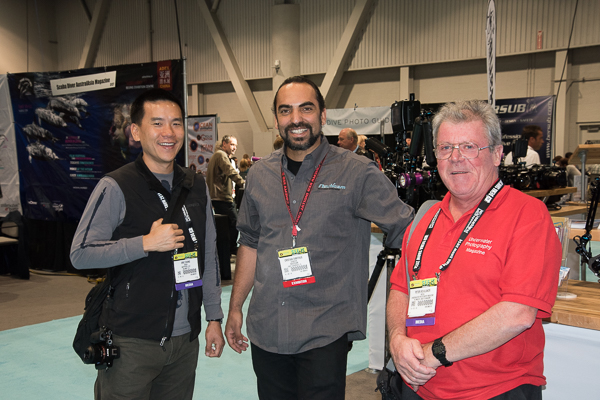
Peter Rowlands
by Alex Mustard
It was impossible to get into underwater photography in the UK, at any time between the 1970s and 1990s, without hearing of Peter Rowlands. At various times he was the Chair of British Society of Underwater Photograpers (BSoUP), the champ of the major competitions, the writer of The Book, the editor of The Magazine and throughout he ran Ocean Optics. Optics, as it was known by all, wasn’t just the UK’s leading UW camera store, it was arguably the most famous in the world, attracting customers from all corners of the globe.
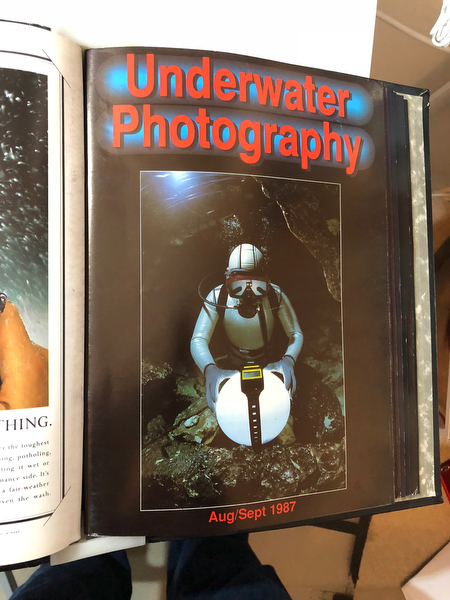
When I started out, I was still at school and relied on Christmas and Birthday presents to slowly build up an underwater system. As a result, Peter actually knew my father long before we finally met. My big break came in 1998, courtesy of Peter, when he was asked by Peter Scoones to coordinate a series of Red Sea charters. Scoones wanted a month in the Red Sea to film for Blue Planet 1, but BBC budgets were tight, so the plan was to fill the charter with the right sort of photographers to offset the costs. I was already having some success in competitions and people knew my name, but nobody had met me (so I wasn’t on anyone’s banned list!) Invite accepted, it changed my life. It was my first Red Sea liveaboard and my time diving with top tier photographers. Peter gave me lots of help through the trip and the week totally changed my approach and transformed my photography.
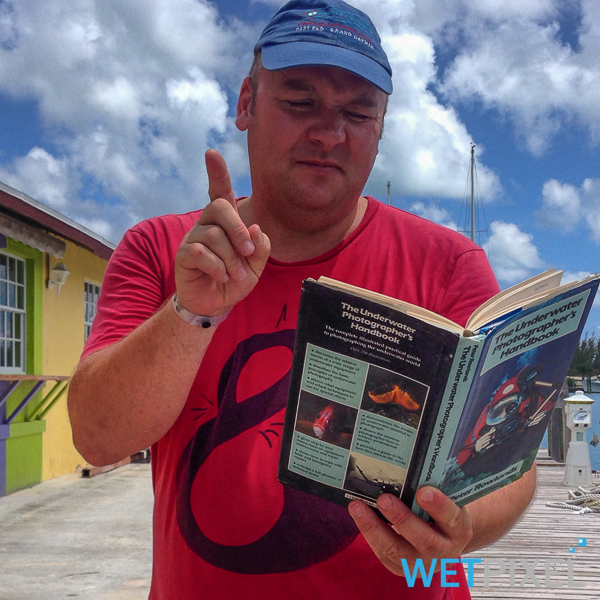
Rowlands is not one to suffer fools, those who have heard his “I am not f***ing Father Christmas” anecdote will be in no doubt that he sold Ocean Optics because he couldn’t face answering the same question, to the same customer, another time. First impressions are important to him and he backs his instinct for people – and I am fortunate that I passed. The timing was lucky for me because Peter was winding down his involvement in Ocean Optics and had satisfied the “testosterone phase” of his photography career. The result was that I found a hugely knowledgeable mentor, who gave truly honest feedback on my ideas and photography. One such idea was a fisheye compatible underwater filter that we developed into the Magic Filter and Peter financed into production. We still sell them 12 years on. Many of these ideas became articles in UwP Magazine and I am proud to have contributed regularly from Issue 1 to Issue 100.
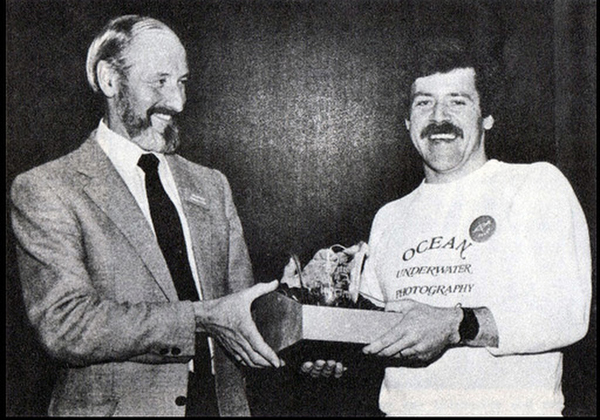
By Martin Edge
I met Peter Rowlands in the early 80’s on my very first visit to BSoUP. I knew the names of all the “celebrity” and to be perfectly honest, when I walked through the door of the pub venue it was like walking into another world for me. Everyone was so friendly and the first “celebrity” I picked up courage to ask a question to, was Peter. I soon purchased a Nikonos camera a flashgun and a few other bits and bobs from his shop Ocean Optics and became set up to do my bit for underwater photography.
One BSoUP evening the speaker for the night did not turn up. So, Peter, Pete Scones, Warren Williams and Colin Doeg took to the floor for a Question & Answer session which for me was like gold dust! To be honest and if my memory serves, I think I may have asked most of the questions. I can still remember the tips, tricks, ideas of that one particular evening and how much important information I acquired on that particular night.

If I look back to the mid to late 1880’s, I can say that, as sure as eggs are eggs, Peter Rowlands was extremely influential on my own learning. By far he was always my first go-to and ,whilst I didn’t perhaps appreciate it back then, I know now that Peter Rowlands has been my one and only mentor. I’m not sure whether he has ever realized this or not!
Together with Alex Mustard, many of you will know that Peter and I judge the UPY Competition. We even sit next to each other! So, I think it is fair to say that we are both good at defending our points of view. We don’t always agree, but vociferously defend our ideas, whilst accepting the other’s.
I have so much respect for Peter Rowlands and all he has achieved in the world of underwater photography. I would like to thank him for the help, advice and guidance he has given to me. Congratulations on the mag Peter and thanks for everything.

Underwater Photography Magazine turns 100
An interview with publisher Peter Rowlands.
WETPIXEL: Congratulations on the issue number 100. What is the secret of your/its success?
Thank you for the kind words, Adam. It’s only beginning to sink in that I have been doing this for seventeen years so there must be some sort of secret but it’s hard to define. However the first obvious one is that the current issue of Underwater Photography Magazine (UwP) has always been free so it’s a no brainer to download it and we have the advertisers to thank for that. Having said that I’d like to think that UwP gives the reader a sense of belonging in an activity which is comparatively solitary. There are very few clubs which dive and shoot images together and the taking underwater images, in the main, is a solitary activity.
WETPIXEL: Prior to UwP, you started a print magazine called Underwater Photographer. How would you compare the challenges of print publishing compared to digital?
I started UP in 1987 and published it bi monthly for two years. Desktop publishing enable me to produce and print the layout but the images, which were mainly transparencies, were all sent to the printers to be scanned. Proofs were then produced and any corrections cost money so unless it was important I had to stick with it. Printed copies were then sent around the world. If I remember rightly we had just over 1,000 subscriptions.
Nowadays I have a desk, a chair, an iMac and a rather slow, but perfectly adequate 8mbs broadband connection. Publishing seems to be in my DNA from school sports reports, dive club newsletters, UP and now UwP. Looking back the emerging technology has made it easier and easier. Now in the past 12 months about 7,000 people worldwide have downloaded one or all issues of UwP.
WETPIXEL: When UwP was launched in 2001, digital imaging technology was very much in its infancy. Did you think that it would become as all pervasive as it is now?
At the time, no but in hindsight it should have been obviously inevitable. Progress, in the main, brings improvements. Believe it or not, in 2001, a lot of people felt that digital imaging was, and never would be, a match for film! I understand some film stocks are being manufactured again like vinyl records but I think that is more about nostalgia than image making.
WETPIXEL: OK-so here is a totally unfair question, but which article has been your favorite over the years?
Every single issue has had what I call a “stand out” article and the fact that I can’t answer your question off the top of my head means that there isn’t one but I’d like to say that the 100 front covers have always been my favourite part of each issue.
WETPIXEL: What has been the biggest challenge in publishing 100 issues?
Producing UwP has rarely felt like a challenge except perhaps when early computer software creaked as the deadline approached. Adobe Pagemaker did a great job and I kicked and screamed when I was forced to “upgrade” to Adobe’s In Design but ever since then the software technology has been amazing.
WETPIXEL: If you were to predict, how do you see UwP being on issue number 200?
Just prior to UwP100 being released we had a genuine “Y2K” moment because the website was set up for Issue numbers with just 2 digits! Fortunately my web site programmer, Richard Watson, who is an unsung hero of mine, was able to rectify things and I joked with him to get ready for UwP1000. He reminded me that would be in 2168!
As to UwP200, I really don’t know but I wouldn’t be surprised if we have 16k video and 200 megapixel SLRs whether we need them or not. By then each issue will probably be a software upgrade which is bionically implanted into your eye so you can read it on the go whilst you are shooting underwater :-)
WETPIXEL: How has technology changed underwater imaging? Do you think the changes are for the better or worse?
The answer must surely be the ability to see your results instantly. That saves a whole lot of time and heartache and that in turn has taken the fear out of underwater photography and that’s got to be for the better.
WETPIXEL: What is the biggest non-technological change that has occurred in underwater imaging in the past 17 years? What has changed in the underwater environment?
I’d like to think that there has been a groundswell move towards more responsible diving when taking underwater images both in terms of how we conduct ourselves physically and our attitude towards our subject matter especially with macro photography.
WETPIXEL: What is the biggest challenge facing underwater image makers?
That’s got to be trying to find a new and unique image but accept that, if you do and it’s a really good one, it will be copied.
WETPIXEL: How long have you been diving for?
I learnt to dive and take underwater photographs at almost the same time in 1972 so that’s me clocked up 45 years and for the majority of those I have had the privilege of being involved in the business of underwater photography. I’d say I have been very lucky to have lived and breathed it. Doing what you enjoy full time doesn’t feel like work.
WETPIXEL: What was your first camera? What was your first underwater camera?
Ah the good old days! My first land camera was a Russian Zenith SLR; screw thread lenses, totally manual including the aperture and not even a built in light meter. My first underwater camera was the Nikonos 11 amphibious camera which I borrowed from my brother who was the manager of Lillywhites Subaqua Dept in Piccadilly Circus. The first underwater camera I actually bought was in fact all the stock at Greens Cameras bankruptcy sale which included a Rolleimarin underwater housing for the Rolleiflex 2 1/4 square format. The administrator didn’t know what it was and I got it for £20! That sale started me on the road to underwater photography equipment and I am immensely grateful.
WETPIXEL: If you had to choose one camera, which camera would it be?
That’s an easy one to answer nowadays. My iPhone! 4k video, SloMo, Timelapse, great stills and stunning panoramas.

WETPIXEL: You were awarded “British Underwater Photographer of the Year” in 1985. What were the winning images of? Do you remember what they were captured with?
I’ve attached a couple of images, one UK and the other Red Sea. The UK shot was with a Nikonos 1V with a home housed 16mm Nikkor full frame fisheye. The Red Sea shot was with a Nikon F2 with actionfinder prism and Sigma 15mm full frame fisheye in an Oceanic Hydro 35 housing. I was also heavily involved in audio visuals at the time with my then dive buddy Steve Birchall and we won that category.
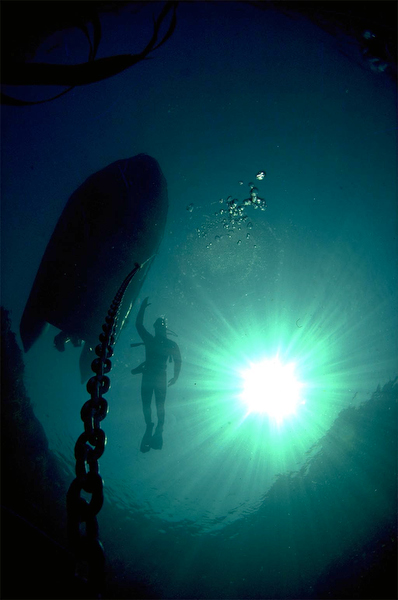
WETPIXEL: I gather you visited the Calypso during the Cousteau era. Can you tell us what it was like?
I was diving the Poor Knights in New Zealand as an individual on a charter boat. I didn’t know anyone on the boat and they didn’t know me. Calypso was moored in a bay near us and their Zodiac came over and they asked the skipper where was a good place to dive. They were in silver wetsuits and I’m pretty sure one of them was Falco. Then I heard a voice from the Zodiac. “Hi Peter. How are you?” It was Norbert Wu who I’d had contact with through Ocean Optics. He was their stills photographer and he invited me to come on board when I was back in Auckland. Calypso was starting to look a bit shabby, to be honest but she had a great presence. The Cyclops submersible was in bits being repaired and the small helicopter looked very precarious. I do remember the smell of something very tasty being cooked, bottles of wine at lunchtime and lots of cigarette smoke.
WETPIXEL: You and Peter Scoones filmed “Last Voyage of the Thistlegorm” for the BBC in 1995. What equipment did you use? How has filmmaking changed since then?
Technically speaking I was Peter’s assistant so I didn’t actually get to shoot any footage but I’d dived the wreck quite a lot by that stage and was able to help with shooting angles and logistics. Peter was shooting with a Sony Betacam in one of his housings and the tapes were slightly larger than a VHS with a run time of just 30 minutes. The sensitivity of the chip was about 50 ISO. Nowadays of course broadcast cameras can shoot for hours at incredibly high ISO and in RAW format so the image came be improved in ‘post’. Peter did everything underwater real time and the final image was ready to edit and broadcast.
WETPIXEL: Who has been the greatest influence on your underwater imaging?
That has to be Peter Scoones; not particularly for his images though they were superb both stills and video but for his total approach to pushing the boundary of the underwater image. Like all brilliant people he made it look easy yet he was always ahead of the game and he changed the way underwater wildlife filming was produced.
WETPIXEL: Do you prefer color or black and white? Color every time and nearly always shot with available light only.
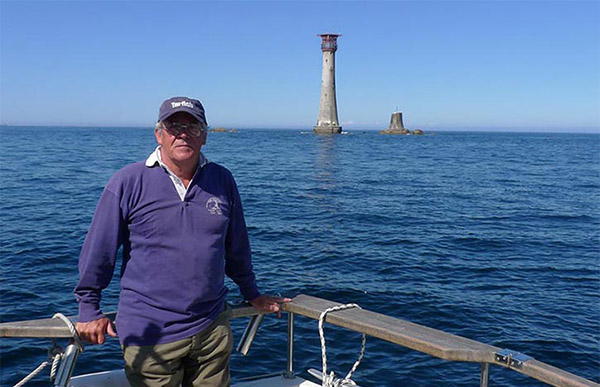
WETPIXEL: What makes for a memorable image?
I have always found it difficult to describe how I feel about images except to say that I know it when I see it. I have chosen 100 UwP front cover images and I’m very proud of all of them (including the ‘white’ one!). I would say that every one of those is a good example of memorable.
WETPIXEL: Where is your favorite dive site? Why is it your favorite?
My favourite dive site is one which I have only dived a few times and which I have not been able to dive since 2000 and it’s the wreck of HMS Royal Oak in Orkney. She’s a protected war grave and I got special permission to document her on film in the 1990’s. 600 feet long in 30 metres of water she is enormous, haunting and captivating. What I wouldn’t give for the chance to dive her again with a digital camera.
WETPIXEL: Do you have a favorite subject or type of subject?
I am drawn to wrecks because they don’t move about, they are best shot with ultra wide angle and available light and they provide a multitude of angles and moods.
WETPIXEL: If you were starting out as an underwater image maker now, what advice would you give to yourself?
Try to enjoy your underwater photography and enjoy looking at other’s work. Don’t treat it as a competition and never forget how lucky you are to be able to visit such a special environment.
WETPIXEL: What is the biggest threat to the oceans? Can underwater image makers be an influence for good?
Unfortunately we (mankind) are the biggest threat to the oceans and that is simply because the majority of people can’t see it and what condition it is in. Also we enjoy eating what lives in it far too much. I have always banged on about how we as underwater photographers are always portraying the underwater world as beautiful which is fine but we should also be recording the reality.
If you haven’t done so yet, you can download issue 100 of UwP for free as a pdf.